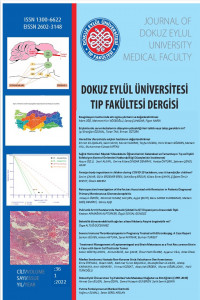Öz
Intruduction: Hereditary spherocytosis (HS) is frequently diagnosed in the pediatric period. Therefore, studies on HS have often been conducted among pediatric patients, and there is no clear data on the disease in adulthood. Our aim was to reveal the follow-up findings of patients with adult HS and their geographic distribution in Turkey.
Materials and Methods: The sample comprised 172 subjects with a HS diagnosis. Data collection commenced retrospectively in February 2004 and was completed by September 2020.
Results: A total of 172 patients, 106 of whom were splenectomized and 66 of whom were non-splenectomized, were included in the study. Mean age of the entire group was 22.7 years. At the time of diagnosis, mean age of the entire group was 12.4 years; for splenectomized and non-splenectomized patients, it was 9.9 years and 16.6 years, respectively (p=0.000). At the time of diagnosis, anemia was more common in the splenectomized group (65.1%) than the non-splenectomized group (45.5%) (p=0.011). Thromboembolic event was not experienced in any patient after splenectomy. None of the patients in the splenectomized group was transfusion-dependent in their last visit, but in the non-splenectomized group, 6 patients (9.1%) were still transfusion-dependent (p=0.003).
Conclusion: Anemia was more common finding at the time of diagnosis and the age at diagnosis was lower in the splenectomized patients. Transfusion-dependency had completely disappeared in splenectomized patients. HS was more frequently seen in the Black Sea, northern Central Anatolia, and northern Marmara regions than in other regions in Turkey.
Anahtar Kelimeler
Kaynakça
- 1. Manciu S, Matei E, Trandafir B. Hereditary Spherocytosis - Diagnosis, Surgical Treatment and Outcomes. A Literature Review. Chirurgia (Bucharest, Romania : 1990). 2017;112(2):110-6.
- 2. Perrotta S, Gallagher PG, Mohandas N. Hereditary spherocytosis. Lancet (London, England). 2008;372(9647):1411-26.
- 3. Bolton-Maggs PH. Hereditary spherocytosis; new guidelines. Archives of disease in childhood. 2004;89(9):809-12.
- 4. Bolton-Maggs PH, Langer JC, Iolascon A, Tittensor P, King MJ, General Haematology Task Force of the British Committee for Standards in H. Guidelines for the diagnosis and management of hereditary spherocytosis--2011 update. British journal of haematology. 2012;156(1):37-49.
- 5. Oliveira MC, Fernandes RA, Rodrigues CL, Ribeiro DA, Giovanardi MF, Viana MB. Clinical course of 63 children with hereditary spherocytosis: a retrospective study. Rev Bras Hematol Hemoter. 2012;34(1):9-13.
- 6. Christensen RD, Yaish HM, Gallagher PG. A pediatrician's practical guide to diagnosing and treating hereditary spherocytosis in neonates. Pediatrics. 2015;135(6):1107-14.
Öz
Intruduction: Hereditary spherocytosis (HS) is frequently diagnosed in the pediatric period. Therefore, studies on HS have often been conducted among pediatric patients, and there is no clear data on the disease in adulthood. Our aim was to reveal the follow-up findings of patients with adult HS and their geographic distribution in Turkey.
Materials and Methods: The sample comprised 172 subjects with a HS diagnosis. Data collection commenced retrospectively in February 2004 and was completed by September 2020.
Results: A total of 172 patients, 106 of whom were splenectomized and 66 of whom were non-splenectomized, were included in the study. Mean age of the entire group was 22.7 years. At the time of diagnosis, mean age of the entire group was 12.4 years; for splenectomized and non-splenectomized patients, it was 9.9 years and 16.6 years, respectively (p=0.000). At the time of diagnosis, anemia was more common in the splenectomized group (65.1%) than the non-splenectomized group (45.5%) (p=0.011). Thromboembolic event was not experienced in any patient after splenectomy. None of the patients in the splenectomized group was transfusion-dependent in their last visit, but in the non-splenectomized group, 6 patients (9.1%) were still transfusion-dependent (p=0.003).
Conclusion: Anemia was more common finding at the time of diagnosis and the age at diagnosis was lower in the splenectomized patients. Transfusion-dependency had completely disappeared in splenectomized patients. HS was more frequently seen in the Black Sea, northern Central Anatolia, and northern Marmara regions than in other regions in Turkey.
Anahtar Kelimeler
Kaynakça
- 1. Manciu S, Matei E, Trandafir B. Hereditary Spherocytosis - Diagnosis, Surgical Treatment and Outcomes. A Literature Review. Chirurgia (Bucharest, Romania : 1990). 2017;112(2):110-6.
- 2. Perrotta S, Gallagher PG, Mohandas N. Hereditary spherocytosis. Lancet (London, England). 2008;372(9647):1411-26.
- 3. Bolton-Maggs PH. Hereditary spherocytosis; new guidelines. Archives of disease in childhood. 2004;89(9):809-12.
- 4. Bolton-Maggs PH, Langer JC, Iolascon A, Tittensor P, King MJ, General Haematology Task Force of the British Committee for Standards in H. Guidelines for the diagnosis and management of hereditary spherocytosis--2011 update. British journal of haematology. 2012;156(1):37-49.
- 5. Oliveira MC, Fernandes RA, Rodrigues CL, Ribeiro DA, Giovanardi MF, Viana MB. Clinical course of 63 children with hereditary spherocytosis: a retrospective study. Rev Bras Hematol Hemoter. 2012;34(1):9-13.
- 6. Christensen RD, Yaish HM, Gallagher PG. A pediatrician's practical guide to diagnosing and treating hereditary spherocytosis in neonates. Pediatrics. 2015;135(6):1107-14.
Ayrıntılar
| Birincil Dil | Türkçe |
|---|---|
| Konular | Klinik Tıp Bilimleri |
| Bölüm | Araştırma Makaleleri |
| Yazarlar | |
| Yayımlanma Tarihi | 30 Nisan 2022 |
| Gönderilme Tarihi | 29 Kasım 2021 |
| Yayımlandığı Sayı | Yıl 2022 Cilt: 36 Sayı: 1 |


